Table of contents
- Product test accessory turn signals 18 mini turn signals from 17.90 to 139.90 euros
- Turn signal regulations

mps

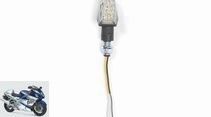
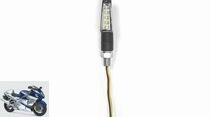
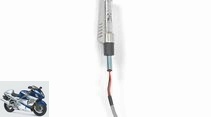
27 pictures
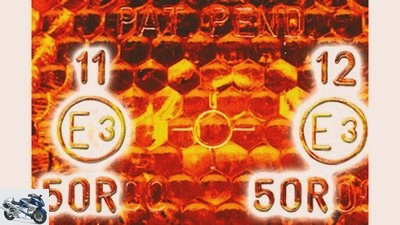
Jenkins
1/27
The code number 12 reveals that this indicator is approved for the rear.

mps
2/27
Rank 13: Polo Corner. The carbon look looks pretty cheap, but the very angular eye-catcher is also available in black, thank God. The light output is slightly below average and the workmanship is only satisfactory to sufficient.
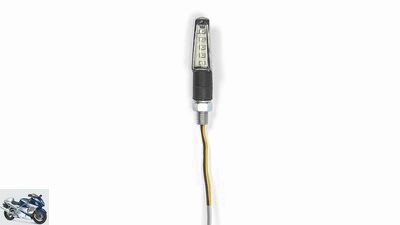
mps
3/27
12th place: Barracuda Futura 2. More expensive and therefore a little better processed than the sister model, but unfortunately with significantly lower light output. The clear design goes well with puristic conversions. Here, too, resistors are standard.
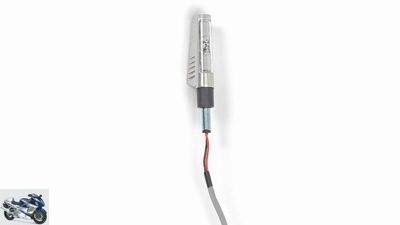
mps
4/27
10th place: Polo Rizoma Graffio. At first glance a very noble aluminum part, but if you take a closer look, you will discover small traces of processing that shouldn’t be at the price. The light output is great and the design is a real blast.
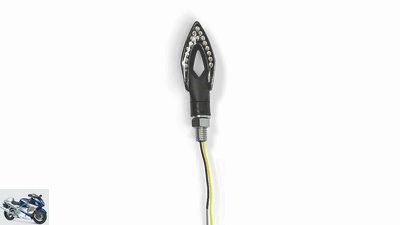
mps
5/27
10th place: Barracuda Freccia. The (somewhat playful) shape makes it, the rest is at best a decent average product and the workmanship (gap dimensions) is only satisfactory. It’s practical that two resistors are included in the scope of delivery.
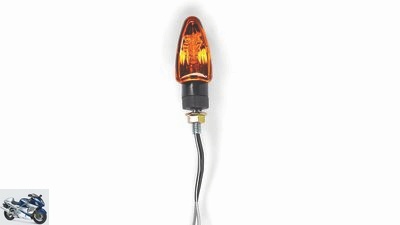
mps
6/27
8th place: Polo Racing II. And another representative from the series “Screw a little and pay little”. Halogen instead of LED technology makes it possible. The light output is okay, the workmanship could be better, but is acceptable for the price.
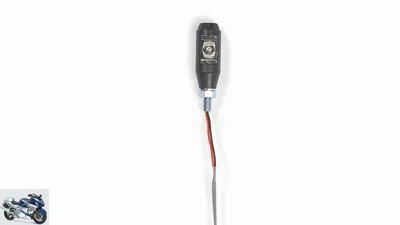
mps
7/27
8th place: Hein Gericke Barrel. The smart barrel shape also ensures good side radiation, but the light output should be a little better. The workmanship is surprisingly good and the price is therefore absolutely reasonable.

mps
8/27
7th place: Louis Xenolen Cobra. Very slim, good to very good workmanship, decent light output – the elegant aluminum part collects a lot of points and is worth the money. But rubber instead of hard plastic bearings would be desirable.
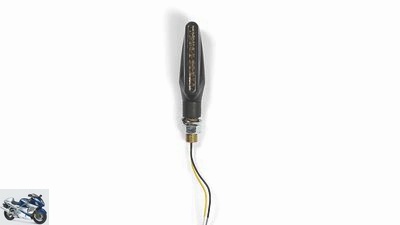
mps
9/27
4th place: Louis LED turn signal 10034023. Those who do not necessarily need an aluminum housing, but value very good light output and good workmanship at an attractive price, are buying the right place here. Only the side radiation could be a bit better.
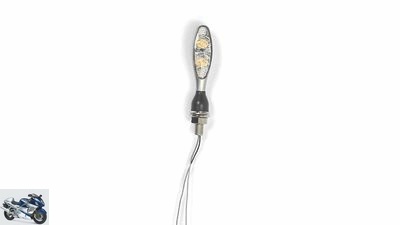
mps
10/27
1st place: Kellermann Micro 1000 Extreme. The part is expensive. Very expensive! And it is worth every penny, because it is almost unbelievable what Kellermann has got out of this perfectly crafted tiny piece in terms of light output. The test victory is the reward for the effort.
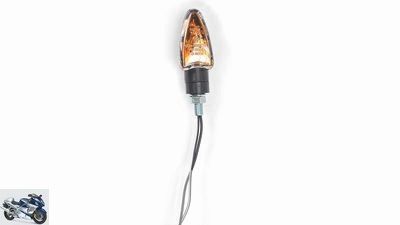
mps
11/27
2nd place: Hein Gericke Oxford Arrow. No relay retrofitting campaigns, no fiddling around with the installation of resistors – it usually just has to be re-plugged. The workmanship is a bit rustic, the light is great and the price is awesome. MOTORCYCLE best buy.
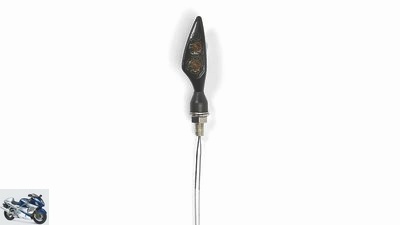
mps
12/27
3rd place: Kellermann Micro Rhombus Dark. Looks sharp, is excellently processed and a real cellar man in all respects. But anyone who has ever seen the Micro 1000 Extreme in action will probably ignore the equally expensive Micro Rhombus Dark.
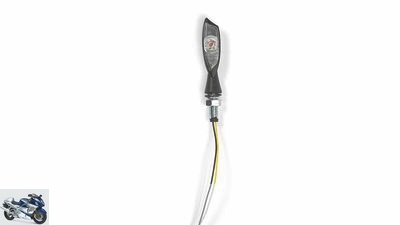
mps
13/27
4th place: Hein Gericke Noble. Well to very well processed aluminum part, which is suspiciously reminiscent of models from Aachen, but in terms of light output does not quite come close to their quality. The price is okay for what is offered.
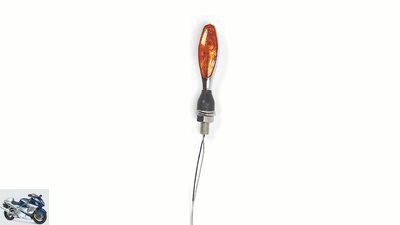
mps
14/27
4th place: Kellermann Micro 1000 Halogen. Each unit costs a whopping 35 euros (!) Less than the almost identical LED sister model in terms of housing. In addition to the lower (but still good) light output, it has a catch, because the great part can only be attached to the rear.
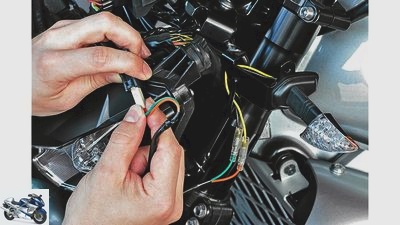
mps
15/27
If you use adapter cables, you can leave the original wiring harness intact. What serves the operational safety and makes the retrofitting a lot easier.
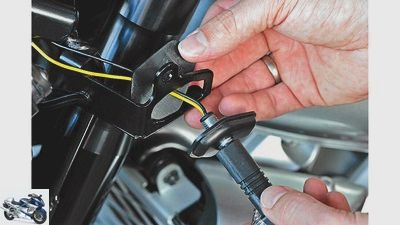
mps
16/27
Recording covers (“spacers”) ensure that the original recordings, which are usually much too large for mini indicators, are elegantly sealed.
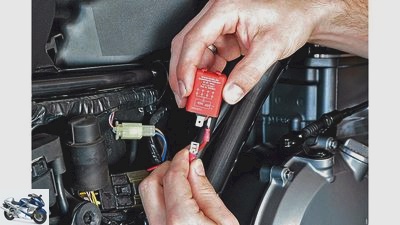
mps
17/27
If the vehicle electrics allow relay replacement, the resistors can be dispensed with. Vital for the relay: correct polarity.
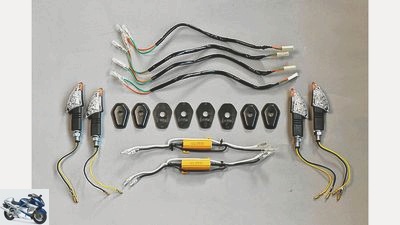
mps
18/27
In addition to LED indicators (left and right), resistors (below), adapter cables (above) and mounting covers (center) are part of the complete conversion program.

mps
19/27
18th place: iXS X-LED WL016. Wild and independent design, plus a really nice light image (stylized arrow), but the light output is the worst in the test, and that costs a lot of points. The processing is satisfactory to good.
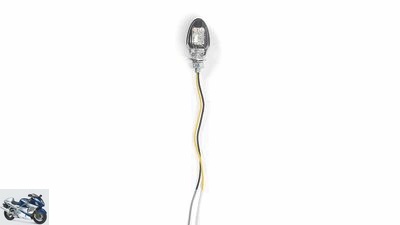
mps
20/27
16th place: Polo Shin Yo Drop. Is it even smaller? Hardly legally. The price looks attractive, but if you take a closer look, you might be surprised at the casual workmanship, miss a rubber mount and want a little more light.
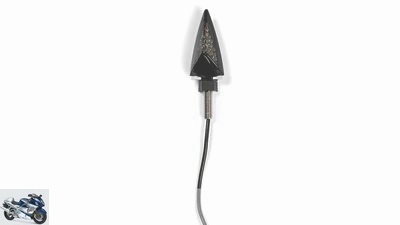
mps
21/27
16th place: Louis Xenolen Predator 10034018. Compared to its sister model Cobra, the significantly worse offer, because the light output is visibly and measurably weaker, and the workmanship is only satisfactory. Nice shape, but too expensive.

mps
22/27
15th place: iXS X-LED WL012. Not very bright, not extremely well made, not shaped very independently – this turn signal is pure inconspicuousness. It doesn’t have to be a bad thing, the price is okay, and it’s pretty small too.
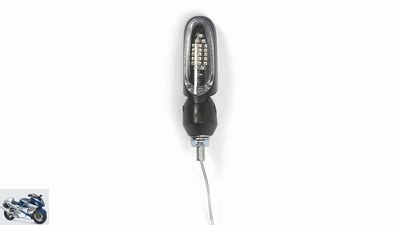
mps
23/27
13th place: Wunderlich folding turn signals Dual Sport. Transport, off-road use – there are situations in which indicators are a nuisance. These neatly processed, unfortunately somewhat dim flip indicators are intended for BMW drivers (and pilots from other manufacturers who like to do handicrafts).
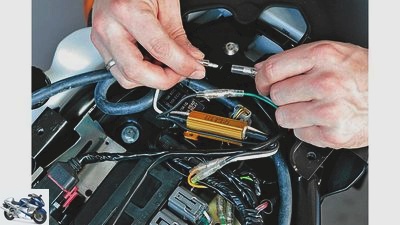
mps
24/27
Resistors ensure that the original flasher relay has no problems with the reduced wattage of the mini turn signals and that the flashing frequency is correct.
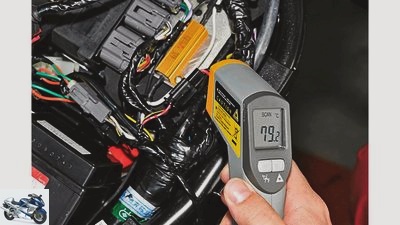
mps
25/27
The catch with the issue of resistance: the parts get very hot during operation and should be “airy” and not mounted directly on plastic parts..
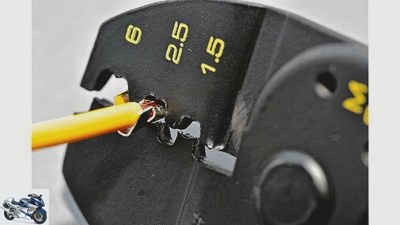
mps
26/27
Luster terminal and insulating tape solutions are botched. A secure connection is only possible by soldering or crimping the cable lugs.
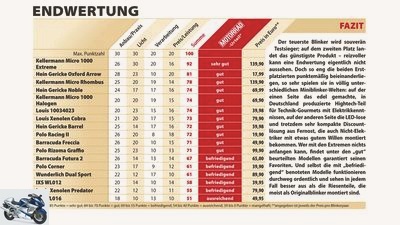
27/27
The test results and prices.
accesories
Product test accessories mini turn signals
Product test accessory turn signals
18 mini turn signals from 17.90 to 139.90 euros
Content of
MOTORRAD compared 18 retrofit indicators, assessed their fit and workmanship and checked whether they are really as easy to install as the manufacturers always promise. In addition, the little luminous miracles had to prove their luminous efficacy in operation. The price range of the candidates ranged from 17.90 euros to 139.90 euros and – that much has already been revealed – the price had surprisingly little to do with the placement.
Klaus Herder
03/20/2013
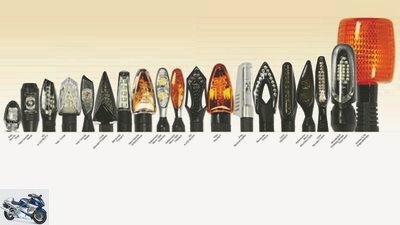
Original rear indicator (far right) of the Honda SC28 and all 18 tested mini indicators.
The one above on the right is a lush 222 gram original rear turn signal from the Honda SC28, commonly known as Fireblade, also shown in its original size. This is what almost all factory-installed indicators looked like 20 years ago, and in direct comparison it becomes clear why legions of motorcyclists have already sacrificed large parts of their free time to replace the original ladle-sized parts with something smaller.
Buy complete article

Product test accessory turn signals
18 mini turn signals from 17.90 to 139.90 euros
6 pages) as PDF
€ 2.00
Buy now
Two decades ago that wasn’t that easy, if you wanted to continue to be legally on the move, because the lighting technology was simply not yet ready to deliver the luminosity required by law at a reasonably affordable rate from the smallest possible light-emitting area. In addition, national approval regulations made all downsizing efforts more difficult until 1998, because the mounting regulations, which were quite rigid, especially in Germany, ensured that direction indicators (as they are called blinkers in official German) had to be mounted very far on the outside, which of course ran counter to the goal of the greatest possible compactness.
However, European approval law has been in force since 1998, and a lot has happened in terms of lighting technology, especially in the last ten years. Keyword LED technology (which stands for “Light Emitting Diodes”): Light-emitting diodes are now used as a natural means of lighting, whether in flashlights or in vehicle construction. Huge advantages of the current-carrying semiconductor components: high luminosity with small dimensions, low power consumption, long service life and low vibration sensitivity. In addition, the tiny ones only need small cable cross-sections to be supplied with juice. In other words, perfect conditions to get a lot of light from a small space. In parallel to the LED hype, however, halogen technology also made tremendous progress, and so the topic of mini turn signals is pursued in two directions nowadays: on the one hand the ultra-compact LED turn signals, on the other hand the mostly not much larger, but still much cheaper Halogen minis. What you decide on is a question of taste, budget and your own screwdriver talent, provided you want to do the conversion yourself; because converting to LED turn signals is usually much more complex than replacing it with halogen models.

mps
Luster terminal and insulating tape solutions are botched. A secure connection is only possible by soldering or crimping the cable lugs.
Many of the current new machines are now factory-fitted with pleasantly small halogen or even LED indicators, but since a motorcycle registered in Germany is on average over 13 years old, there is still a lot of catching up to do – the mini indicator business continues to boom. Guido Kellermann was one of the first to recognize the possibilities and has been manufacturing (legal) mini indicators in Aachen since 1995. His high-tech products are now synonymous with an entire product group. Just as you blow your nose with the “speed” and screw with the “Allen”, so you assemble “cellar men”. Which is both a blessing and a curse for the inventor of the original, because because of the high level of brand awareness, there are now many Kellermann doppelgangers who do not come from Aachen but from the Far East and who do not come close to those in Germany that are flatterers in terms of quality – which is not least also this test proves once again.
But regardless of whether you opt for the supposed “original”, a replica or a completely independently designed LED-
Mini-blinker decides: You should have at least a basic knowledge of vehicle electrics and be aware that the thing usually involves a bit of screwdriver effort. In practice, at least one and a half come for something
In the case of more built-in motorcycles, it can also take four hours to convert.
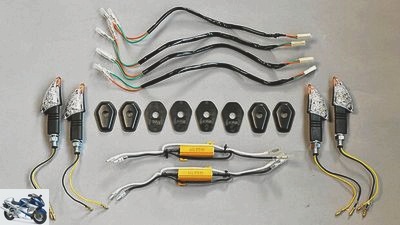
mps
In addition to LED indicators (left and right), resistors (below), adapter cables (above) and mounting covers (center) are part of the complete conversion program.
LEDs require significantly less electricity than conventional light bulbs. They mostly work with one or two watts, whereas (older) serial indicators usually require ten, 18 or 21 watts. And of course the flasher relay responsible for the correct flashing frequency is designed for precisely these higher wattages. If this is now “under-challenged” by the new mini indicators, it increases the flashing frequency or ensures that the light is permanently on.
There are two ways to avoid this. On the one hand, the relay exchange, ideally for a load-independent part, which is available from around 13 euros in the relevant accessories trade. The catch: Relay replacement usually does not work if the turn signals have a common control lamp, a flashing beeper or a hazard warning system is available, or the original relay is part of a multifunctional electronic unit, i.e. not a separate component – recognizable by more than three cable outlets . In such cases, only solution number two remains: the installation of additional resistors. These are used to simulate the original flasher relay with a higher wattage. How many ohms the resistors used must have depends on the difference between the wattage of the original turn signals and the LED turn signals. Some suppliers (including Barracuda, Rizoma and Wunderlich) deliver their accessory indicators already complete with pre-assembled resistors. As accessories, such parts cost around seven euros each. If you want to treat yourself to the whole retrofitting topic a little more intensively, take a look at the workshop history in MOTORRAD 13/2012 or on the Internet at www.louis.de (Tips & Tricks / mounting LED turn signals), where the Louis screwdriver crew very detailed and good
clearly describes the problems that can arise and what needs to be done.

mps
If you use adapter cables, you can leave the original wiring harness intact. What serves the operational safety and makes the retrofitting a lot easier.
In order to find out which mini turn signal one would like to deal with in lonely screwdriving lessons, this story may provide some decision-making aid. With all the technical advantages and disadvantages and with all the different prices, it should be clear that this is not a rational purchase decision, because you buy a product that can actually do nothing better than the part that is already attached to the motorcycle . It flashed before the renovation and it will continue to flash afterwards. Additional benefit? None, except for increased eye flattery, and therefore the design is probably the decisive purchase factor in almost all cases.
But if you still need a few rational reasons, you will find the heading “Light measurement” in the table above. For that went
MOTORRAD with all the indicators in the darkened photo studio and measured with a professional light meter how much light the indicator, switched to permanent light, delivers. The unitless value is usually used as a factor for exposure compensation, in which case it is a good reference value. The original Honda indicators have a value of twelve. The human eye perceives the 13.5 of the front runner as clearly brighter, the ten of the last place as clearly darker, but far from being fuzzy. What this means in practice: All the indicators shown here shine beautifully yellow, but legally they are in the green area.
Turn signal regulations
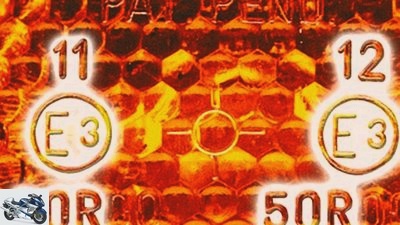
Jenkins
The code number 12 reveals that this indicator is approved for the rear.
The correct test mark on the indicator glass and the correct attachment ensure that there is no trouble with the main inspection or with the police after the conversion and that the indicators do not have to be entered separately in the papers. The flashing frequency must be 90 cycles (± 30) per minute. Indicators approved at the front have the code number 1, 1a, 1b or 11. Indicators approved at the rear can be identified by the code numbers 2, 2a, 2b or 12.
Most indicators are tested for front and rear mounting, so they have two key figures. If the motorcycle is approved according to EC law (almost all vehicles built from 1998 onwards), the following dimensions apply: distance between the rear indicators at least 180 mm, distance between the front indicators at least 240 mm. Height from the front and rear of the road 350 to 1200 mm. For older motorcycles (before 1998) approved under German law, the following applies: distance at the rear at least 240 mm, distance at the front at least 340 mm with a distance of 100 mm to the headlight. Minimum height to the roadway 350 mm.
Related articles
-
New mini turn signals for motorcycles
Wunderkind Custom accesories New mini turn signals for motorcycles New mini turn signals for motorcycles Small in appearance, big in effect Mini turn…
-
Product test: top-class sports helmets in comparison
2snap clothing Helmets Product test: top-class sports helmets in comparison Comparative test sports helmets of the upper class Well protected with the…
-
Product test full face helmets with sun visor
Photo: Herder 51 pictures mps photo studio 1/51 Airoh Movement, MOTORRAD verdict: very good (motorcycle purchase tip). mps photo studio 2/51 HJC RPHA ST,…
-
mps photo studio clothing Helmets Product test: Schuberth C3 Product test: Schuberth C3 Shut up, the next one In cooperation with her head tester Michael…
-
Product test: motorcycle denim jackets
Lohse 17th pictures Lohse 1/17 Of course, there is only one thing that can realistically test whether the jeans clothes really hold up: a fall. Since no…
-
Product test: waterproof short boots
jkuenstle.de clothing Boots Product test: waterproof short boots Product test: waterproof short boots Waterproof short boots in comparison Through the…
-
Sdun clothing Station wagons, jackets & pants Product test: textile jackets Product test: textile jackets Jackets for winter Icy outside, cozy and warm…
-
Test winner mini indicator (MOTORRAD 3-2013)
mps studio accesories Test winner mini indicator (MOTORRAD 3/2013) Test winner mini indicator (MOTORRAD 3/2013) Kellermann Micro 1000 Extreme The…
-
BILLION clothing Boots Product test: boots Product test: boots Touring boots up to 100 euros Where is the shoe pinching? About the price? It shouldn’t be…
-
Product test: motorcycle jeans
Lohse 17th pictures Lohse 1/17 Of course, there is only one thing that can realistically test whether the jeans clothes really hold up: a fall. Since no…